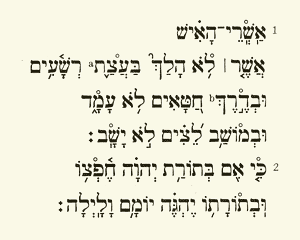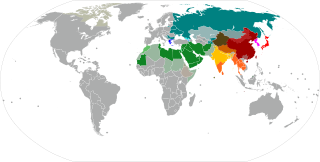
In computing, plain text is a loose term for data that represent only characters of readable material but not its graphical representation nor other objects. It may also include a limited number of "whitespace" characters that affect simple arrangement of text, such as spaces, line breaks, or tabulation characters. Plain text is different from formatted text, where style information is included; from structured text, where structural parts of the document such as paragraphs, sections, and the like are identified; and from binary files in which some portions must be interpreted as binary objects.
ISO/IEC 8859-8, Information technology — 8-bit single-byte coded graphic character sets — Part 8: Latin/Hebrew alphabet, is part of the ISO/IEC 8859 series of ASCII-based standard character encodings. ISO/IEC 8859-8:1999 from 1999 represents its second and current revision, preceded by the first edition ISO/IEC 8859-8:1988 in 1988. It is informally referred to as Latin/Hebrew. ISO/IEC 8859-8 covers all the Hebrew letters, but no Hebrew vowel signs. IBM assigned code page 916 to it. This character set was also adopted by Israeli Standard SI1311:2002, with some extensions.
ISO/IEC 8859-6:1999, Information technology — 8-bit single-byte coded graphic character sets — Part 6: Latin/Arabic alphabet, is part of the ISO/IEC 8859 series of ASCII-based standard character encodings, first edition published in 1987. It is informally referred to as Latin/Arabic. It was designed to cover Arabic. Only nominal letters are encoded, no preshaped forms of the letters, so shaping processing is required for display. It does not include the extra letters needed to write most Arabic-script languages other than Arabic itself.

Complex text layout (CTL) or complex text rendering is the typesetting of writing systems in which the shape or positioning of a grapheme depends on its relation to other graphemes. The term is used in the field of software internationalization, where each grapheme is a character.
This article provides basic comparisons for notable text editors. More feature details for text editors are available from the Category of text editor features and from the individual products' articles. This article may not be up-to-date or necessarily all-inclusive.

Many East Asian scripts can be written horizontally or vertically. Chinese characters, Korean hangul, and Japanese kana may be oriented along either axis, as they consist mainly of disconnected logographic or syllabic units, each occupying a square block of space, thus allowing for flexibility for which direction texts can be written, be it horizontally from left-to-right, horizontally from right-to-left, vertically from top-to-bottom, and even vertically from bottom-to-top.
A whitespace character is a character data element that represents white space when text is rendered for display by a computer.

In a right-to-left, top-to-bottom script, writing starts from the right of the page and continues to the left, proceeding from top to bottom for new lines. Arabic, Hebrew, and Persian are the most widespread RTL writing systems in modern times.

A Hebrew keyboard comes in two different keyboard layouts. Most Hebrew keyboards are bilingual, with Latin characters, usually in a US Qwerty layout. Trilingual keyboard options also exist, with the third script being Arabic or Russian, due to the sizable Arabic- and Russian-speaking populations in Israel.
The left-to-right mark (LRM) is a control character used in computerized typesetting of text containing a mix of left-to-right scripts and right-to-left scripts. It is used to set the way adjacent characters are grouped with respect to text direction.
The right-to-left mark (RLM) is a non-printing character used in the computerized typesetting of bi-directional text containing a mix of left-to-right scripts and right-to-left scripts.

The Unicode Consortium and the ISO/IEC JTC 1/SC 2/WG 2 jointly collaborate on the list of the characters in the Universal Coded Character Set. The Universal Coded Character Set, most commonly called the Universal Character Set, is an international standard to map characters, discrete symbols used in natural language, mathematics, music, and other domains, to unique machine-readable data values. By creating this mapping, the UCS enables computer software vendors to interoperate, and transmit—interchange—UCS-encoded text strings from one to another. Because it is a universal map, it can be used to represent multiple languages at the same time. This avoids the confusion of using multiple legacy character encodings, which can result in the same sequence of codes having multiple interpretations depending on the character encoding in use, resulting in mojibake if the wrong one is chosen.
Many Unicode characters are used to control the interpretation or display of text, but these characters themselves have no visual or spatial representation. For example, the null character is used in C-programming application environments to indicate the end of a string of characters. In this way, these programs only require a single starting memory address for a string, since the string ends once the program reads the null character.

Panorama is a line layout and text composition engine to render text in various worldwide languages made by Bitstream Inc. Panorama uses Font Fusion as the base to support rendering of the text. The engine allows the user to manage different text formatting aspects like spacing, alignment, style effects.
The Universal Coded Character Set is a standard set of characters defined by the international standard ISO/IEC 10646, Information technology — Universal Coded Character Set (UCS), which is the basis of many character encodings, improving as characters from previously unrepresented typing systems are added.

A writing system comprises a particular set of symbols, called a script, as well as the rules by which the script represents a particular language. Writing systems can generally be classified according to how symbols function according to these rules, with the most common types being alphabets, syllabaries, and logographies. Alphabets use symbols called letters that correspond to spoken phonemes. Abjads generally only have letters for consonants, while pure alphabets have letters for both consonants and vowels. Abugidas use characters that correspond to consonant–vowel pairs. Syllabaries use symbols called syllabograms to represent syllables or moras. Logographies use characters that represent semantic units, such as words or morphemes.
The Unicode Standard assigns various properties to each Unicode character and code point.
General Punctuation is a Unicode block containing punctuation, spacing, and formatting characters for use with all scripts and writing systems. Included are the defined-width spaces, joining formats, directional formats, smart quotes, archaic and novel punctuation such as the interrobang, and invisible mathematical operators.
The Arabic letter mark (ALM) is a non-printing character used in the computerized typesetting of bi-directional text containing mixed left-to-right scripts and right-to-left scripts.
Trojan Source is the name of a software vulnerability that abuses Unicode's bidirectional characters to display source code differently than the actual execution of the source code. The exploit utilizes how writing scripts of different reading directions are displayed and encoded on computers. It was discovered by Nicholas Boucher and Ross Anderson at Cambridge University in late 2021.











